Editorial
Does Age Matter for Personality Psychology?
Cornelia Wrzus,
Corresponding Author
Cornelia Wrzus
Psychological Institute, Ruprecht Karls University Heidelberg, Heidelberg, Germany
Correspondence to: Cornelia Wrzus, Psychological Institute, Ruprecht Karls University Heidelberg, Heidelberg, Germany.
E-mail: [email protected]
Search for more papers by this authorCornelia Wrzus,
Corresponding Author
Cornelia Wrzus
Psychological Institute, Ruprecht Karls University Heidelberg, Heidelberg, Germany
Correspondence to: Cornelia Wrzus, Psychological Institute, Ruprecht Karls University Heidelberg, Heidelberg, Germany.
E-mail: [email protected]
Search for more papers by this author
References
- Allemand, M., & Hill, P. (2019). Future time perspective and gratitude in daily life: A micro-longitudinal study. European Journal of Personality, 33, 65–110.
10.1002/per.2201 Google Scholar
- Baltes, P. B., Reese, H. W., & Lipsitt, L. P. (1980). Life-span developmental psychology. Annual Review of Psychology, 31, 65–110. https://doi.org/10.1146/annurev.ps.31.020180.000433
- Bleidorn, W., Schönbrodt, F. D., Gebauer, J., Rentfrow, P. J., Potter, J., & Gosling, S. D. (2016). To live among like-minded others: Exploring the links between person-city personality fit and self-esteem. Psychological Science, 27, 419–427. https://doi.org/10.1177/0956797615627133
- Bühler, J. L., Weidmann, R., Nikitin, J., & Grob, A. (2019). A closer look at life goals across adulthood: Applying a developmental perspective to content, dynamics, and outcomes of goal importance and goal attainability. European Journal of Personality, 33.
10.1002/per.2194 Google Scholar
- Cramer, A. O. J., Van der Sluis, S., Noordhof, A., Wichers, M., Geschwind, N., Aggen, S. H., Kendler, K. S., et al. (2012). Dimensions of normal personality as networks in search of equilibrium: You can't like parties if you don't like people. European Journal of Personality, 26, 414–431. https://doi.org/10.1002/per.1866
- Fleeson, W., & Gallagher, P., (2009). The implications of Big Five standing for the distribution of trait manifestation in behavior: Fifteen experience-sampling studies and a meta-analysis. Journal of Personality and Social Psychology, 97, 1097–1114. https://doi.org/10.1037/a0016786
- Gerstorf, D., Ram, N., Goebel, J., Schupp, J., Lindenberger, U., & Wagner, G. G. (2010). Where people live and die makes a difference: Individual and geographic disparities in well-being progression at the end of life. Psychology and Aging, 25, 661–676. https://doi.org/10.1037/a0019574
- Kandler, C., Waaktaar, T., Mõttus, R., Riemann, R., & Torgersen, S. (2019). Unraveling the interplay between genetic and environmental contributions in the unfolding of personality differences from early adolescence to young adulthood. European Journal of Personality, 33.
10.1002/per.2189 Google Scholar
- Kaplan, H. S., & Gangestad, S. W. (2005). Life history theory and evolutionary psychology. In D. M. Buss (Ed.), The handbook of evolutionary psychology (pp. 68–95). Hoboken, NJ: Wiley.
- Lang, F. R., & Carstensen, L. L. (2002). Time counts: Future time perspective, goals, and social relationships. Psychology and Aging, 17, 125–139. https://doi.org/10.1037/0882-7974.17.1.125
- Lucas, R. E., & Donnellan, M. B. (2011). Personality development across the life span: Longitudinal analyses with a national sample from Germany. Journal of Personality and Social Psychology, 101, 847–861. https://doi.org/10.1037/a0024298
- McAdams, D. P., & Olson, B. D. (2010). Personality development: Continuity and change over the life course. Annual Review of Psychology, 61, 517–542. https://doi.org/10.1146/annurev.psych.093008.100507
- D. P. McAdams, R. L. Shiner, & J. L. Tackett (Eds) (2019). Handbook of personality development. New York: Guilford.
- Müller, S., Ram, N., Conroy, D. E., Pincus, A. L., Gerstorf, D., & Wagner, J. (2019). Happy like a fish in water? The role of personality–situation fit for momentary happiness in social interactions across the adult life span. European Journal of Personality, 33.
- Nestler, S., Back, M. D., & Egloff, B. (2011). Psychometrische Eigenschaften zweier Skalen zur Erfassung interindividueller Unterschiede in der Präferenz zum Alleinsein [psychometric properties of the two scales for assessing individual differences in preference for solitude]. Diagnostica, 57, 57–67. https://doi.org/10.1026/0012-1924/a000032
- Nikitin, J., & Freund, A. (2019). Individual differences in habitual social goals and daily well-being: The role of age and relationship closeness. European Journal of Personality, 33.
10.1002/per.2190 Google Scholar
- Noftle, E., & Gust, C. J. (2019). Age differences across adulthood in interpretations of situations and situation-behavior contingencies for big five states. European Journal of Personality, 33.
10.1002/per.2203 Google Scholar
- Olaru, G., Schroeders, U., Hartung, J., & Wilhelm, O. (2019a). Ant colony optimization and local weighted structural equation modeling: A tutorial on novel item and person sampling procedures for personality research. European Journal of Personality, 33.
10.1002/per.2195 Google Scholar
- Olaru, G., Schroeders, U., Wilhelm, O., & Ostendorf, F. (2019b). “Grandpa, do you like roller coasters?”: Identifying age-appropriate personality indicators. European Journal of Personality, 33.
10.1002/per.2185 Google Scholar
- Orth, U., Erol, R. Y., & Luciano, E. C. (2018). Development of self-esteem from age 4 to 94 years: A meta-analysis of longitudinal studies. Psychological Bulletin., 144, 1045–1080. https://doi.org/10.1037/bul0000161
- Ostendorf, F., & Angleitner, A. (2004). NEO-PI-R. NEO-Persönlichkeitsinventar nach Costa und McCrae. Revidierte Fassung. Göttingen: Kluwer Hogrefe.
- Ozer, D. J., & Benet-Martinez, V. (2006). Personality and the prediction of consequential outcomes. Annual Review of Psychology, 57, 401–421. https://doi.org/10.1146/annurev.psych.57.102904.190127
- Pusch, S., Mund, M., Hagemeyer, B., & Finn, C. (2019). Personality development in emerging and young adulthood: A study of age differences. European Journal of Personality, 33.
10.1002/per.2181 Google Scholar
- Roberts, B. W., & Caspi, A. (2003). In U. Staudinger, & U. Lindenberger (Eds.), Understanding human development lifespan psychology in exchange with other disciplines The cumulative continuity model of personality development: Striking a balance between continuity and change in personality traits across the life course. Dordrecht: Kluwer Academic.
- Roberts, B. W., Kuncel, N. R., Shiner, R., Caspi, A., & Goldberg, L. R. (2007). The power of personality: The comparative validity of personality traits, socio-economic status, and cognitive ability for predicting important life outcomes. Perspectives on Psychological Science, 2, 313–345. https://doi.org/10.1111/j.1745-6916.2007.00047.x
- Roberts, B. W., Walton, K. E., & Viechtbauer, W. (2006). Patterns of mean-level change in personality traits across the life course: A meta-analysis of longitudinal studies. Psychological Bulletin, 132, 1–25. https://doi.org/10.1037/0033-2909.132.1.1
- Wagner, J., Voelkle, M., & Lüdtke, O. (2019). Using dynamic panel models to study age-related differences and time-related changes in personality. European Journal of Personality, 33.
10.1002/per.2200 Google Scholar
- Wrzus, C. (2019). Effects of personality traits on intrapersonal, interpersonal, and institutional outcomes from a lifespan perspective. Manuscript in preparation.
- Wrzus, C., Wagner, G. G., & Riediger, M. (2016). Personality-situation-transactions from adolescence to old age. Journal of Personality and Social Psychology, 110, 782–799. https://doi.org/10.1037/pspp0000054
- Zheng, A., Briley, D. A., Malanchini, M., Tackett, J. L., Harden, K. P., & Tucker-Drob, E. M. (2019). Genetic and environmental influences on achievement goal orientations shift with age. European Journal of Personality, 33.
10.1002/per.2202 Google Scholar




